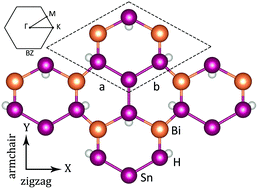Thermoelectric properties of hydrogenated Sn2Bi monolayer under mechanical strain: a DFT approach†
Abstract
Bismuth based structures are among the most promising candidates for thermoelectric applications. Recently, a semiconducting binary compound with stoichiometry of Sn2Bi has been synthesized, showing a strong spin–orbit coupling effect and high electron–hole asymmetry. Motivated by the experiment, we performed a density functional theory calculation combined with the semiclassical Boltzmann transport equation to investigate the thermoelectric properties of the stabilized Sn2Bi monolayer. It is demonstrated that the mobility is strongly dependent on the strain. It is 2389 (186) cm2 V−1 s−1 for hole (electron) in relaxed monolayer, but it becomes 1758 (1758) cm2 V−1 s−1 by applying a 2.5% tensile strain. Spin–orbit coupling (SOC) induces a huge spin splitting in the conduction and valence bands as high as 350 and 270 meV, respectively, coming from p orbitals of bismuth atoms. Also, the thermoelectric efficiency of the monolayer could be directly controlled by doping and strain where the maximum room temperature figure of merit of 1.01 is obtained under the strain of 3% for n-type doping with inclusion of SOC, making it a promising candidate for thermoelectric applications.



 Please wait while we load your content...
Please wait while we load your content...